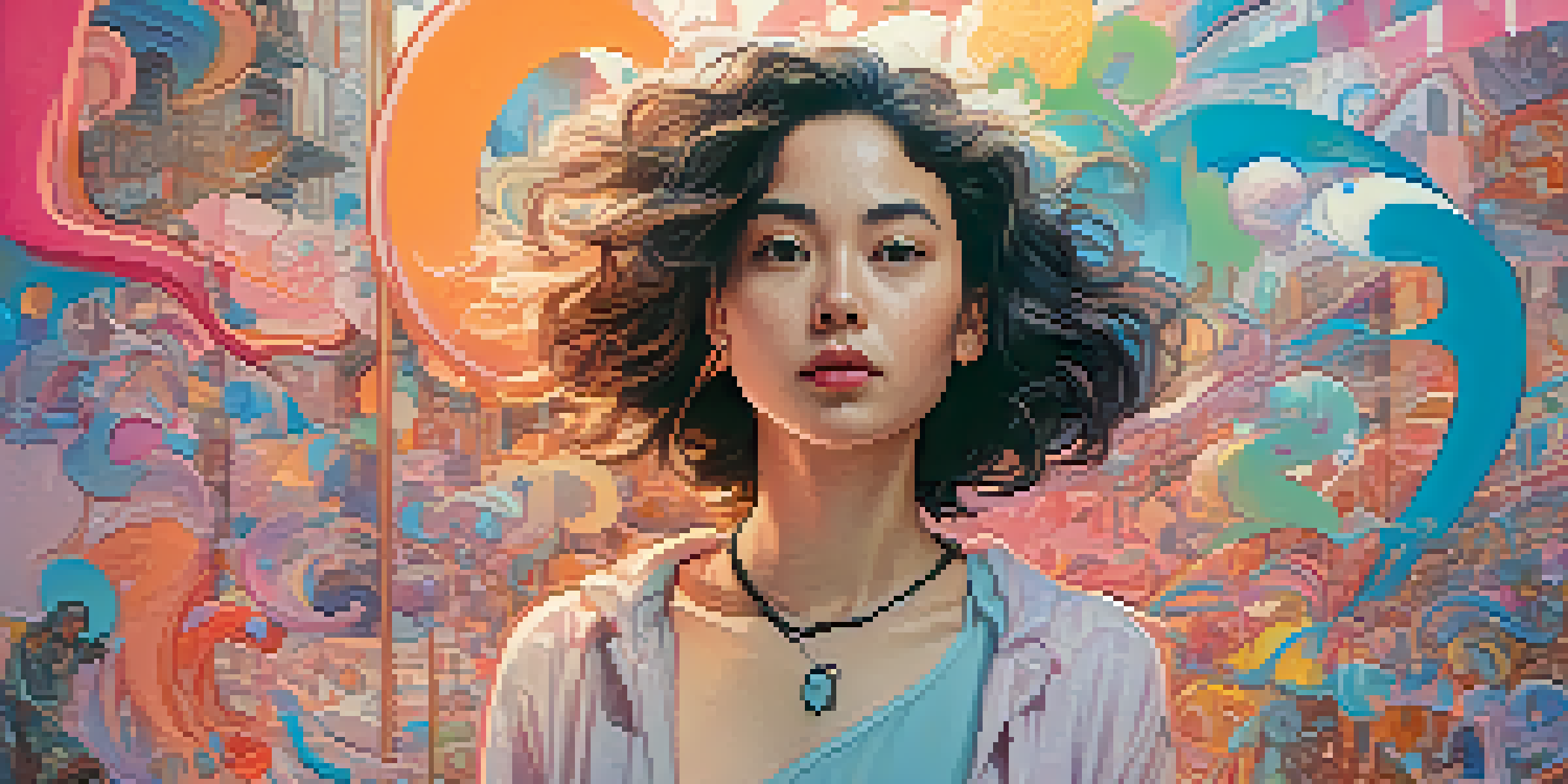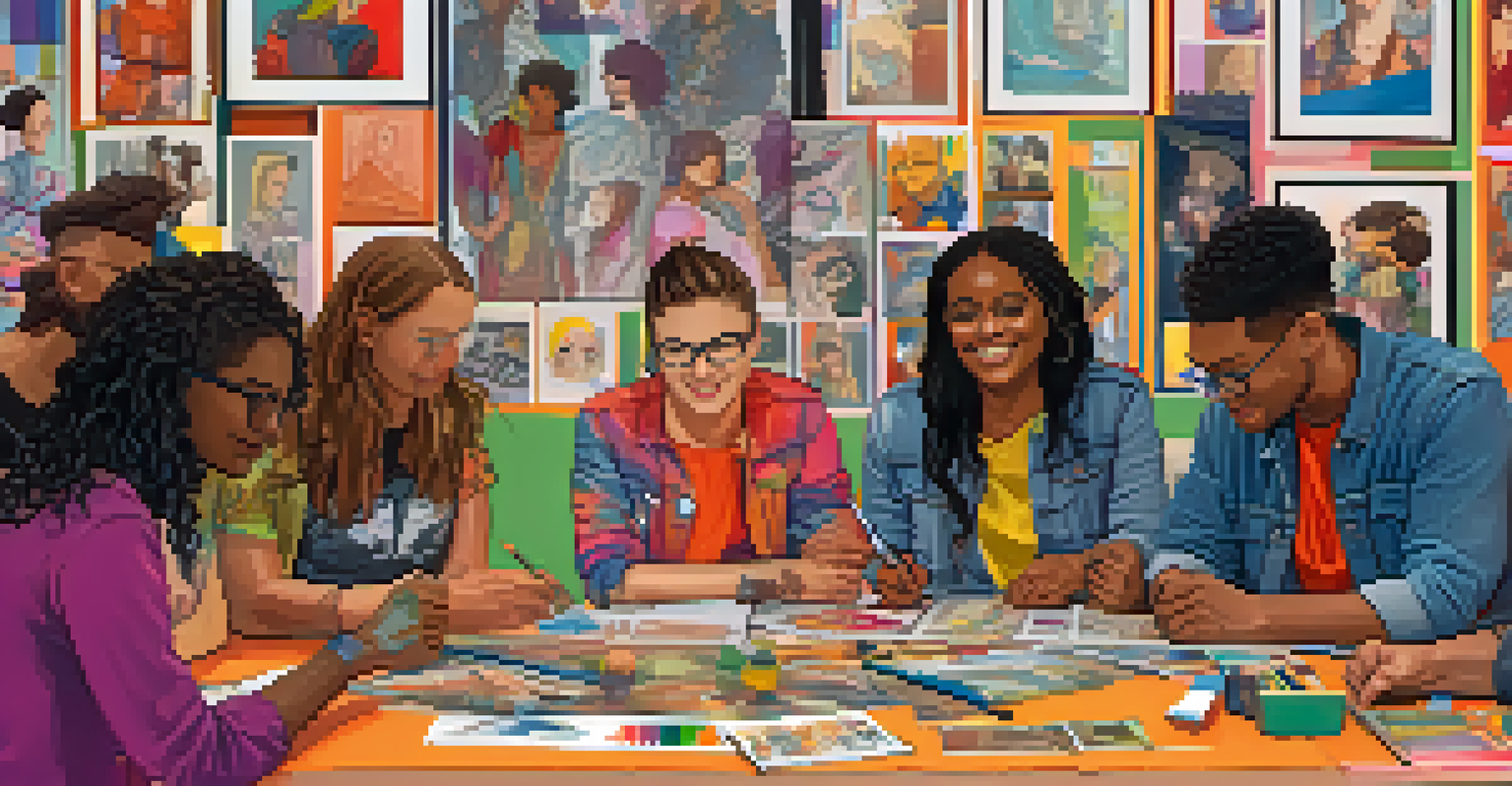Visual Narratives of Gender Identity in Graphic Novels

Understanding Gender Identity in Graphic Novels
Gender identity is a nuanced concept that refers to how individuals perceive themselves and what they call themselves. In graphic novels, this identity often unfolds visually, providing readers with a unique perspective. The marriage of visuals and text allows creators to explore complex themes, making gender identity relatable and understandable.
Representation matters immensely in literature, and graphic novels are no exception.
For example, characters may embody traits or roles that challenge traditional gender norms, prompting readers to reflect on their own perceptions. These narratives can serve as mirrors for readers, allowing them to see different aspects of their identity represented. Graphic novels thus become a powerful medium for exploring and discussing gender.
Moreover, the visual elements in graphic novels—such as color, style, and character design—can reinforce or contrast gender identities. When creators select certain visual cues, they communicate deeper meanings about the characters' experiences and struggles. This potent combination of imagery and storytelling makes graphic novels an impactful tool for understanding gender identity.
The Role of Representation in Graphic Novels
Representation matters immensely in literature, and graphic novels are no exception. When diverse gender identities are portrayed, it opens the door for empathy and understanding among readers. Seeing characters that mirror one’s own experiences can validate feelings of isolation or confusion, which is often felt by those exploring their gender identity.

Take, for instance, the graphic novel 'Gender Queer' by Maia Kobabe, which offers a candid look into the author's journey of self-discovery. Its honest portrayal allows readers to navigate their own thoughts on gender identity. Such representation not only enlightens readers but also fosters community and support for marginalized voices.
Gender Identity Explored Visually
Graphic novels use a combination of visuals and text to effectively communicate complex themes surrounding gender identity.
Furthermore, representation in graphic novels can challenge societal norms, encouraging readers to question the status quo. By showcasing a spectrum of gender identities, these narratives can dismantle stereotypes and promote inclusivity. Ultimately, this broader representation cultivates a richer understanding of gender in our society.
Visual Storytelling Techniques in Gender Exploration
Graphic novels utilize various storytelling techniques to convey gender identity effectively. One powerful method is the use of color symbolism, where specific shades evoke emotions or signify gender traits. For instance, the use of soft pastels might represent fluidity in gender, while bold colors may signify defiance against traditional norms.
The future of gender narratives in graphic novels promises exciting possibilities.
Additionally, the layout and panel structure can impact how gender narratives are perceived. For example, a fragmented or non-linear storytelling approach can mirror the complexity of one’s identity journey, emphasizing that gender is not always a straightforward path. This creative freedom allows readers to engage with the narrative on multiple levels.
Character expressions and body language also play a crucial role in visual storytelling. Subtle cues in a character’s posture or facial expressions can reveal their internal struggles with gender identity. By employing these techniques, graphic novels create a rich, immersive experience that invites readers to empathize with the characters' journeys.
Impact of Cultural Context on Gender Narratives
Cultural context significantly influences how gender identity is depicted in graphic novels. Different societies have varying expectations and norms surrounding gender, which can shape the narratives presented. For instance, in cultures with rigid gender roles, graphic novels may explore the tension between personal identity and societal expectations.
Additionally, graphic novels from diverse cultural backgrounds can offer unique insights into gender identity. Works like 'The Prince and the Dressmaker' by Jen Wang illustrate the intersection of culture and gender, highlighting how societal norms can both constrain and inspire individual expression. These narratives enrich the conversation around gender by showcasing a variety of cultural perspectives.
Importance of Diverse Representation
Diverse portrayals of gender identities in graphic novels foster empathy and understanding among readers, validating personal experiences.
Moreover, as globalization expands access to diverse stories, readers can engage with gender identities outside their own experiences. This exposure fosters a greater understanding of the complexities of gender in various cultural contexts, encouraging readers to appreciate and respect different perspectives.
Challenges Faced by Authors in Gender Representation
Authors and illustrators of graphic novels often face challenges when representing gender identity authentically. Striking a balance between personal experience and universal themes can be tricky. There's a fine line between sharing a genuine narrative and inadvertently reinforcing stereotypes or misconceptions about gender.
Additionally, the risk of misrepresentation looms large, especially for stories that center on identities outside the author's own experience. This has led to ongoing discussions about 'own voices' in literature, emphasizing the importance of authentic representation. It’s crucial for creators to conduct thorough research and engage with communities to portray gender identities accurately.
Moreover, the commercial aspect of graphic novels can also create pressure to conform to mainstream narratives. Publishers may prioritize stories that align with popular trends, potentially sidelining more complex, lesser-known gender identities. Despite these challenges, many authors continue to push boundaries and strive for more inclusive storytelling.
The Evolution of Gender Identity in Graphic Novels
The portrayal of gender identity in graphic novels has evolved significantly over the years. Early graphic novels often relied on binary representations of gender, which limited the exploration of more fluid identities. However, as societal understanding of gender has expanded, so too has the representation within the medium.
Today, many graphic novels feature a diverse array of characters that challenge traditional gender binaries. This shift has allowed for more inclusive storytelling that resonates with a broad audience. Works like 'Lumberjanes' celebrate friendship and adventure while embracing various gender identities, reflecting a more comprehensive view of gender.
Cultural Influence on Gender Narratives
Cultural contexts shape the depiction of gender identities in graphic novels, providing unique insights that enrich the overall conversation.
As readers become increasingly aware of gender fluidity and non-binary identities, graphic novels continue to adapt and innovate. This ongoing evolution not only mirrors societal changes but also positions graphic novels as essential tools for discussing and understanding gender identity in contemporary culture.
Future Directions for Gender Narratives in Graphic Novels
Looking ahead, the future of gender narratives in graphic novels promises exciting possibilities. As more creators emerge from diverse backgrounds, we can expect an even wider range of experiences and perspectives. This diversity will enrich the medium and provide readers with varied stories that reflect the complexities of gender identity.
With the rise of digital publishing, graphic novels are becoming more accessible to audiences worldwide. This democratization of storytelling allows for niche voices to be heard, potentially giving rise to groundbreaking narratives around gender. As these stories reach broader audiences, they can challenge stereotypes and foster understanding.

Moreover, the integration of interactive elements in graphic novels may provide innovative ways to explore gender identity. By allowing readers to engage with narratives in unique ways, creators can deepen the exploration of gender and encourage personal reflection. The future is bright for graphic novels as they continue to evolve alongside society's understanding of gender.